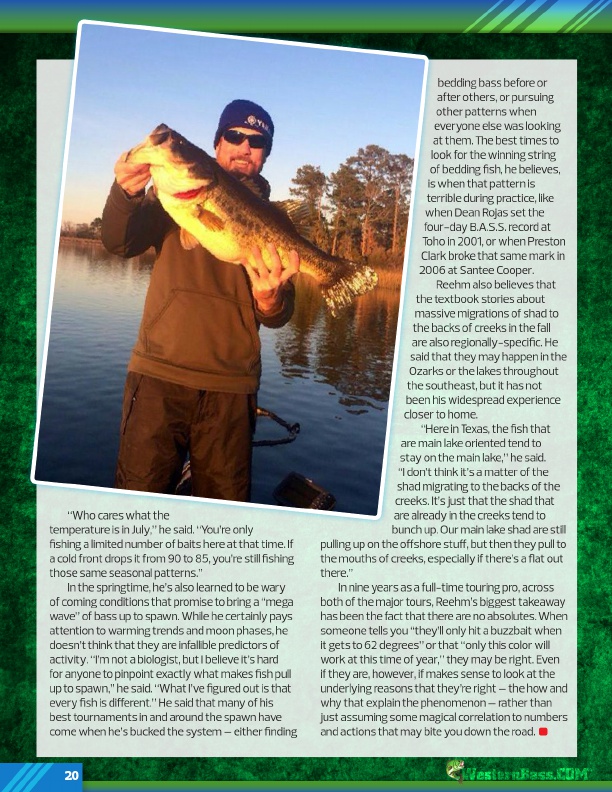
®
“Who cares what the temperature is in July,” he said. “You’re only fishing a limited number of baits here at that time. If a cold front drops it from 90 to 85, you’re still fishing those same seasonal patterns.”
In the springtime, he’s also learned to be wary of coming conditions that promise to bring a “mega wave” of bass up to spawn. While he certainly pays attention to warming trends and moon phases, he doesn’t think that they are infallible predictors of activity. “I’m not a biologist, but I believe it’s hard for anyone to pinpoint exactly what makes fish pull up to spawn,” he said. “What I’ve figured out is that every fish is different.” He said that many of his best tournaments in and around the spawn have come when he’s bucked the system – either finding
bedding bass before or
after others, or pursuing
other patterns when
everyone else was looking
at them. The best times to
look for the winning string
of bedding fish, he believes,
is when that pattern is
terrible during practice, like
when Dean Rojas set the
four-day B.A.S.S. record at
Toho in 2001, or when Preston
Clark broke that same mark in
2006 at Santee Cooper.
Reehm also believes that
the textbook stories about
massive migrations of shad to
the backs of creeks in the fall
are also regionally-specific. He
said that they may happen in the
Ozarks or the lakes throughout
the southeast, but it has not
been his widespread experience
closer to home.
“Here in Texas, the fish that
are main lake oriented tend to
stay on the main lake,” he said.
“I don’t think it’s a matter of the
shad migrating to the backs of the
creeks. It’s just that the shad that
are already in the creeks tend to
bunch up. Our main lake shad are still pulling up on the offshore stuff, but then they pull to the mouths of creeks, especially if there’s a flat out there.”
In nine years as a full-time touring pro, across both of the major tours, Reehm’s biggest takeaway has been the fact that there are no absolutes. When someone tells you “they’ll only hit a buzzbait when it gets to 62 degrees” or that “only this color will work at this time of year,” they may be right. Even if they are, however, if makes sense to look at the underlying reasons that they’re right – the how and why that explain the phenomenon – rather than just assuming some magical correlation to numbers and actions that may bite you down the road.
20